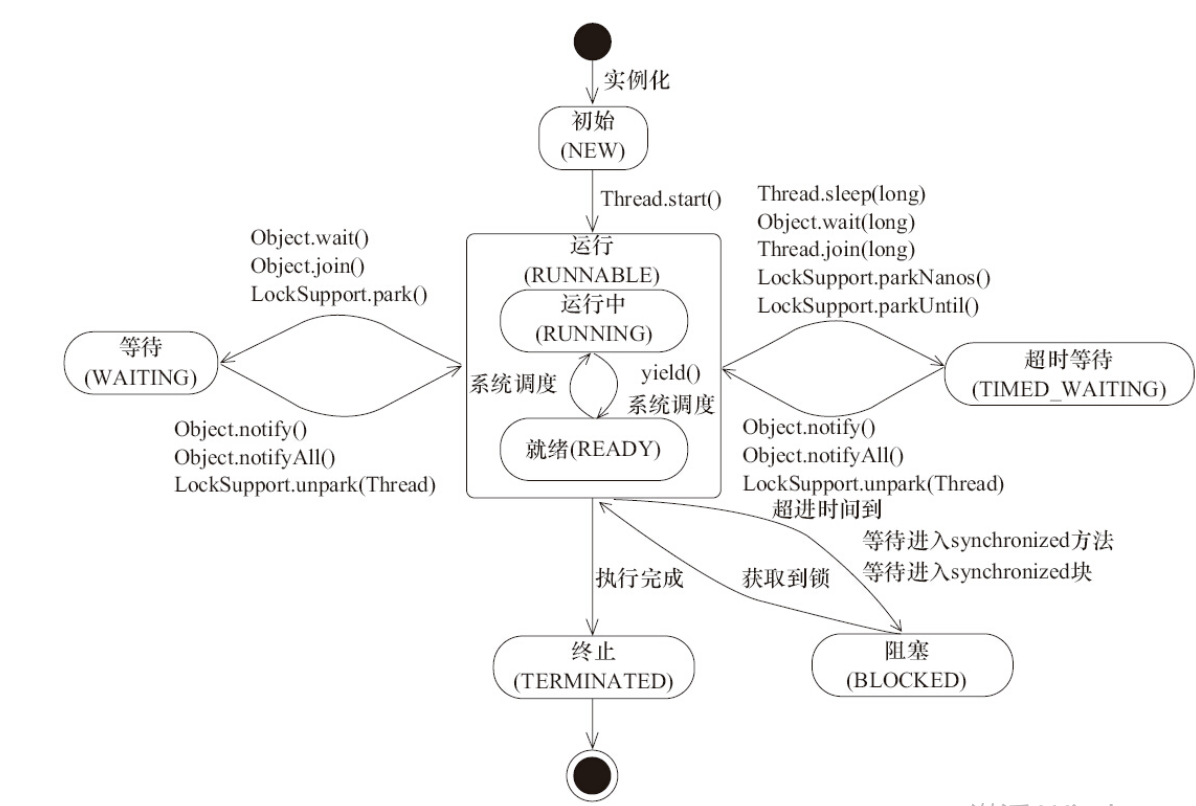常见面试题:创建一个线程的常用方法有哪些?Thread创建线程和Runnable创建线程有什么区别?
答案通常集中在,继承类和实现接口的差别上面;
如果深入问一些问题:1.要执行的任务写在run()方法中,为什么要用start()方法启动?等等问题
简单的问题还是可以回答一哈子,但是涉及到深入些的问题,就只能看看源码,才能更好的回答问题了:
1.为啥线程要用start()方法启动?
首先要从Thread类的源码入手:
- Thread类实现了Runnable接口
public
class Thread implements Runnable {
- 可以看出,Thread类里面有一个Runnable接口的元素,通过构造方法给Thread类里面的Runnable元素赋值;
private Runnable target;
public Thread(Runnable target) {
init(null, target, "Thread-" + nextThreadNum(), 0);
}
private void init(ThreadGroup g, Runnable target, String name,
long stackSize, AccessControlContext acc,
boolean inheritThreadLocals) {
//省略部分代码
this.group = g;
this.daemon = parent.isDaemon();
this.priority = parent.getPriority();
//......省略部分代码
this.target = target;//注意这里的赋值操作
setPriority(priority);
if (inheritThreadLocals && parent.inheritableThreadLocals != null)
this.inheritableThreadLocals =
ThreadLocal.createInheritedMap(parent.inheritableThreadLocals);
/* Stash the specified stack size in case the VM cares */
this.stackSize = stackSize;
/* Set thread ID */
tid = nextThreadID();
}
- run方法很简单,就是判断是不是通过构造函数传入了Runnable接口,可以看出,线程的方法并没有执行;
@Override
public void run() {
if (target != null) {
target.run();
}
}
- start()方法中通过调用start0()执行Run()方法;类似于this.run();报错后也是忽略状态
public synchronized void start() {
if (threadStatus != 0)
throw new IllegalThreadStateException();
group.add(this);
boolean started = false;
try {
start0();
started = true;
} finally {
try {
if (!started) {
group.threadStartFailed(this);
}
} catch (Throwable ignore) {
/* do nothing. If start0 threw a Throwable then
it will be passed up the call stack */
}
}
}
private native void start0();
- 可以借鉴的地方:
将任务封装在单独的接口中,可以多种实现,通过统一的方法去调用;
interface A {
run(){)
}
class B implements A {
private A a;
B(){}
B(A a){this.a = a}
run(){
if(a != null ){a.run}
}
start(){this.run()}
}
2.Thread的几种状态
- 类中给出的几种状态
public enum State {
/**
* Thread state for a thread which has not yet started.
*/
NEW,
/**
* Thread state for a runnable thread. A thread in the runnable
* state is executing in the Java virtual machine but it may
* be waiting for other resources from the operating system
* such as processor.
*/
RUNNABLE,
/**
* Thread state for a thread blocked waiting for a monitor lock.
* A thread in the blocked state is waiting for a monitor lock
* to enter a synchronized block/method or
* reenter a synchronized block/method after calling
* {@link Object#wait() Object.wait}.
*/
BLOCKED,
/**
* Thread state for a waiting thread.
* A thread is in the waiting state due to calling one of the
* following methods:
* <ul>
* <li>{@link Object#wait() Object.wait} with no timeout</li>
* <li>{@link #join() Thread.join} with no timeout</li>
* <li>{@link LockSupport#park() LockSupport.park}</li>
* </ul>
*
* <p>A thread in the waiting state is waiting for another thread to
* perform a particular action.
*
* For example, a thread that has called <tt>Object.wait()</tt>
* on an object is waiting for another thread to call
* <tt>Object.notify()</tt> or <tt>Object.notifyAll()</tt> on
* that object. A thread that has called <tt>Thread.join()</tt>
* is waiting for a specified thread to terminate.
*/
WAITING,
/**
* Thread state for a waiting thread with a specified waiting time.
* A thread is in the timed waiting state due to calling one of
* the following methods with a specified positive waiting time:
* <ul>
* <li>{@link #sleep Thread.sleep}</li>
* <li>{@link Object#wait(long) Object.wait} with timeout</li>
* <li>{@link #join(long) Thread.join} with timeout</li>
* <li>{@link LockSupport#parkNanos LockSupport.parkNanos}</li>
* <li>{@link LockSupport#parkUntil LockSupport.parkUntil}</li>
* </ul>
*/
TIMED_WAITING,
/**
* Thread state for a terminated thread.
* The thread has completed execution.
*/
TERMINATED;
}
下面这个图能更好的理解线程的状态
(图片来自《java并发编程艺术》)

1.线程开启,存在两种情况,运行状态和临时阻塞状态(调用方法,但没有获取到锁的情况下);
运行状态,具有执行资格和执行权;临时阻塞状态,只有执行资格没有执行权;
2.线程运行完之后有两种状态:冻结/等待和TERMINATED,
冻结状态释放执行权和执行资格。调用wait()或sleep()方法
3.interceptor和stop之间的区别
stop:终结一个线程不会保证资源释放,比较暴力;
interceptor:线程被中断了,可以通过isInterceptor方法获取是否被终端;但是抛异常,或者isItercepter方法后,终端状态会被清楚;
比较好的线程终止方案,可以增加一个标识符eg:flag=true的判断,要中断的时候,将标识符设置位false即可;
4.什么是自旋锁?什么是无锁编程?
CAS简单了解: https://www.cnblogs.com/perferect/p/12761558.html
5.死锁
死锁的定义:一组互相竞争资源的线程因互相等待,导致“永久”阻塞的现象。
最常出现死锁的情况是,当两个或多个锁互相嵌套,一个锁内部进行其他锁的竞争;
class test{
private static final Object obj1 = new Object();
private static final Object obj2 = new Obbject();
public static void main(String[] args){
new Thread(){
public void run(){
synchronized(obj1){
Thread.sleep(100);
synchronized(obj2){
Thread.sleep(200);
}
}
}
}.start();
new Thread(){
public void run(){
synchronized(obj2){
Thread.sleep(100);
synchronized(obj1){
Thread.sleep(200);
}
}
}
}.start();
}
}